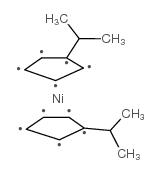57197-55-4
| Name | bis(i-propylcyclopentadienyl)nickel |
|---|
| Molecular Formula | C16H22Ni |
|---|---|
| Molecular Weight | 273.03900 |
| Exact Mass | 272.10700 |
| LogP | 4.09540 |
|
Section 1: Product Identification Chemical Name:Bis(i-propylcyclopentadienyl)nickel, min. 98% CAS Registry Number:57197-55-4 Formula:[(C3H7)C5H4]2Ni EINECS Number:none Chemical Family:organometallic complexes Synonym:Bis(1-methylethylcyclopentadienyl)nickel (II)
Section 2: Composition and Information on Ingredients IngredientCAS NumberPercentACGIH (TWA)OSHA (PEL) Title compound57197-55-4100%0.2mg/m3 (as Ni)1mg/m3 (as Ni) Section 3: Hazards Identification Emergency Overview:Irritating to skin, eyes and mucous membranes. Nickel and certain nickel compounds may cause cancer. Primary Routes of Exposure:Ingestion, eyes Eye Contact:Causes slight to mild irritation of the eyes Skin Contact:Causes slight to mild irritation of the skin. Inhalation:Irritating to the nose, mucous membranes and respiratory tract. Ingestion:Ingestion may lead to vomiting, and diarrhea. Acute Health Affects:Irritating to skin, eyes and respiratory tract. Chronic Health Affects:No information available on long-term chronic effects. May cause cancer. NTP:Yes IARC:Yes OSHA:No SECTION 4: First Aid Measures Immediately flush the eyes with copious amounts of water for at least 10-15 minutes. A victim may need Eye Exposure: assistance in keeping their eye lids open. Get immediate medical attention. Wash the affected area with water. Remove contaminated clothes if necessary. Seek medical assistance if Skin Exposure: irritation persists. Remove the victim to fresh air. Closely monitor the victim for signs of respiratory problems, such as difficulty Inhalation: in breathing, coughing, wheezing, or pain. In such cases seek immediate medical assistance. Seek medical attention immediately. Keep the victim calm. Give the victim water (only if conscious). Induce Ingestion: vomiting only if directed by medical personnel. SECTION 5: Fire Fighting Measures Flash Point:none Autoignition Temperature:none Explosion Limits:none Extinguishing Medium:carbon dioxide, foam or dry powder If this product is involved in a fire, fire fighters should be equipped with a NIOSH approved positive pressure Special Fire Fighting Procedures: self- contained breathing apparatus and full protective clothing. Hazardous Combustion andIf involved in a fire this material may emit irritating fumes. Decomposion Products: Unusual Fire or Explosion Hazards: Highly flammable. Formation of explosive air/vapor mixtures is possible. SECTION 6: Accidental Release Measures Spill and Leak Procedures:Small spills can be absorbed into vermiculite or other chemical adsorbent and swept up. SECTION 7: Handling and Storage Store cold. Keep area away from heat and direct sunlight. This product may degrade on contact with air. Handling and Storage: Store under an inert atmosphere of nitrogen or argon. SECTION 8: Exposure Controls and Personal Protection Eye Protection:Always wear approved safety glasses when handling a chemical substance in the laboratory. Skin Protection:Wear protective clothing and gloves. Ventilation:If possible, handle the material in an efficient fume hood. If ventilation is not available a respirator should be worn. The use of respirators requires a Respirator Respirator: Protection Program to be in compliance with 29 CFR 1910.134. Ventilation:If possible, handle the material in an efficient fume hood. Additional Protection:No additional protection required. SECTION 9: Physical and Chemical Properties Color and Form:green liquid Molecular Weight:273.04 Melting Point:no data Boiling Point:no data Vapor Pressure:no data Specific Gravity:no data Odor:none Solubility in Water:insoluble SECTION 10: Stability and Reactivity Stability:air sensitive (store cold) Hazardous Polymerization:none Conditions to Avoid:contact with strong oxidizing agents Incompatibility:strong oxidizing agents Decomposition Products:carbon dioxide, carbon monoxide, organic fumes, and nickel oxide. SECTION 11: Toxicological Information RTECS Data:No information available in RTECS. Carcinogenic Effects:Nickel and certain nickel compounds are anticipated to be carcinogens. Mutagenic Effects:No data available Tetratogenic Effects:No data available SECTION 12: Ecological Information Ecological Information:No information available SECTION 13: Disposal Considerations Disposal:Dispose of according to local, state and federal regulations. SECTION 14: Transportation Shipping Name (CFR):Flammable liquids, N.O.S. Hazard Class (CFR):3 Additional Hazard Class (CFR):NA Packaging Group (CFR):II UN ID Number (CFR):UN #1993 Shipping Name (IATA):Flammable liquid, N.O.S. Hazard Class (IATA):3 Additional Hazard Class (IATA):NA Packaging Group (IATA):II UN ID Number (IATA):UN# 1993 SECTION 15: Regulatory Information TSCA:not listed on the TSCA inventory SARA (Title 313):See Category Code N495 for reporting. Second Ingredient:none SECTION 16 - ADDITIONAL INFORMATION N/A |
| Risk Phrases | 10-43-45 |
|---|---|
| Safety Phrases | S16-S23-S45-S53 |
| RIDADR | UN 1993 |
